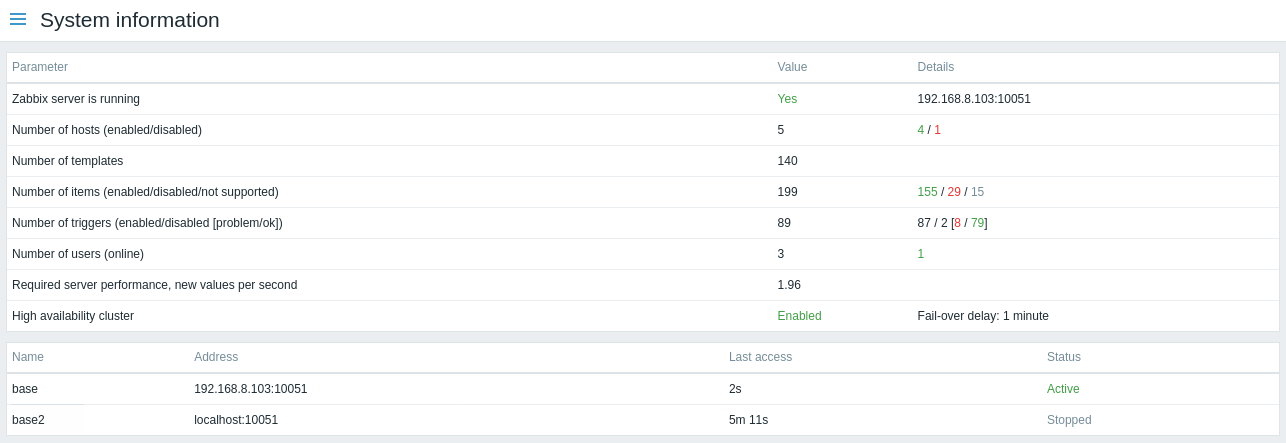1 System information
Overview
In Reports → System information a summary of key Zabbix server and system data is displayed.
Note that in a high availability setup, it is possible to redirect the system information source (server instance) by editing the ui/conf/zabbix.conf.php file - uncomment and set $ZBX_SERVER, $ZBX_SERVER_PORT to a server other than the one shown active.
With the high availability setup enabled, a separate block is displayed below the system stats with details of high availability nodes. This block is visible to Zabbix Super Admin users only.
System information is also available as a dashboard widget.
System stats

Displayed data:
| Parameter | Value | Details |
|---|---|---|
| Zabbix server is running | Status of Zabbix server: Yes - server is running No - server is not running Note: To display the rest of the information the web frontend needs the server to be running and there must be at least one trapper process started on the server (StartTrappers parameter in zabbix_server.conf file > 0). |
Location and port of Zabbix server. |
| Number of hosts | Total number of hosts configured is displayed. | Number of monitored hosts/not monitored hosts. |
| Number of templates | Total number of templates is displayed. | |
| Number of items | Total number of items is displayed. | Number of monitored/disabled/unsupported items. Items on disabled hosts are counted as disabled. |
| Number of triggers | Total number of triggers is displayed. | Number of enabled/disabled triggers. [Triggers in problem/ok state.] Triggers assigned to disabled hosts or depending on disabled items are counted as disabled. |
| Number of users | Total number of users configured is displayed. | Number of users online. |
| Required server performance, new values per second | The expected number of new values processed by Zabbix server per second is displayed. | Required server performance is an estimate and can be useful as a guideline. For precise numbers of values processed, use the zabbix[wcache,values,all] internal item.Enabled items from monitored hosts are included in the calculation. Log items are counted as one value per item update interval. Regular interval values are counted; flexible and scheduling interval values are not. The calculation is not adjusted during a "nodata" maintenance period. Trapper items are not counted. |
| Database history tables upgraded | Database upgrade status: No - database history tables have not been upgraded |
This field is displayed if database upgrade to extended range for numeric (float) values has not been completed. See instructions for enabling an extended range of numeric (float) values. |
| High availability cluster | Status of high availability cluster for Zabbix server: disabled - standalone server enabled - at least one high availability node exists |
If enabled, the failover delay is displayed. |
System information will also display an error message if:
- the database used does not have the required character set or collation (UTF-8);
- the version of the database is below or above supported range (available only to users with the Super admin role type).
High availability nodes
If high availability cluster is enabled, then another block of data is displayed with the status of each high availability node.

Displayed data:
| Column | Description |
|---|---|
| Name | Node name, as defined in server configuration. |
| Address | Node IP address and port. |
| Last access | Time of node last access. Hovering over the cell shows the timestamp of last access in long format. |
| Status | Node status: Active - node is up and working Unavailable - node hasn't been seen for more than failover delay (you may want to find out why) Stopped - node has been stopped or couldn't start (you may want to start it or delete it) Standby - node is up and waiting |

